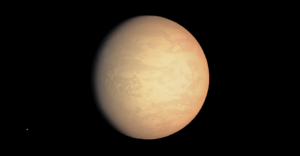Clara (Pacifica)
 Space probe photography of Clara and its only moon (bottom left corner) | |||||||||
| Designations | |||||||||
|---|---|---|---|---|---|---|---|---|---|
| Pronunciation | /ˈklɑːrə/ | ||||||||
| Orbital characteristics | |||||||||
| Aphelion | 0.390 AU (58.343 million km) | ||||||||
| Perihelion | 0.383 AU (57.296 million km) | ||||||||
| 0.387 AU (57.894 million km) | |||||||||
| Eccentricity | 0.0073 | ||||||||
| 0.24 years (87.660 d) | |||||||||
Average orbital speed | 48.20 km/s (29.95 mi/s) | ||||||||
| Inclination | 3.38° to invariable plane | ||||||||
| 158° | |||||||||
| Known satellites | 1 | ||||||||
| Physical characteristics | |||||||||
Equatorial radius | 25,559 km (15,882 mi) | ||||||||
| 8.2091×109 km2 (3.1696×109 sq mi) | |||||||||
| Volume | 6.99×1015 km3 (1.677×1015 cu mi) | ||||||||
| Mass | 8.6594×1025 kg (1.9091×1026 lb) | ||||||||
Mean density | 1.27 g/cm3 (0.0459 lb/cu in) | ||||||||
| 8.85 m/s2 (29.0 ft/s2; 0.902 g0) | |||||||||
| 21.3 km/s (13.2 mi/s) | |||||||||
| 2 month 27 d 14 h, 2.92 months, 87.58 days | |||||||||
| 0.98° (to orbit) | |||||||||
| Albedo | 0.176 (Bond) 0.352 (Geometric) | ||||||||
| |||||||||
| -8.11 to -6.46 | |||||||||
| −3.824 | |||||||||
Clara is the first planet from the Sun and the third-largest in the Pacifica System. It is a gas giant with an average radius of about four times that of Pacifica. It has only one-sixth the average density of Pacifica, but is over 14.5 times more massive. The planet is the smallest out of all the gas giants of the Pacifica System. It orbits the Sun at a distance of 0.39 AU (58 million km) with an orbital period of 88 days, and its rotational period closely resembles its orbital period due to the planet being tidally locked.
Clara's interior is believed to be composed of a rocky core surrounded by an ocean of metallic hydrogen, while the exterior is composed of a gaseous layer, and an electrical current within the metallic hydrogen layer is thought to give rise to Clara's planetary magnetic field. The outer atmosphere is generally bland and lacking in contrast with bands so faint they are hard to observe with the naked eye, however, upper clouds are visible, and some features can appear spontaneously.
The planet doesn't have an apparent ring system, and it holds gravitational influence over a single moon.
Physical characteristics
Clara is a gas giant composed predominantly of hydrogen and helium. It lacks a definite surface, though it is likely to have a solid core. Clara's rotation causes it to have the shape of an oblate spheroid; that is, it is flattened at the poles and bulges at its equator. Due to the low density of Clara, the effective surface gravity along the equator, 8.85 m/s2, is lower than the surface gravity of Pacifica. However, the equatorial escape velocity of 21 km/s is almost two times that of Pacifica.
Internal structure
Despite consisting mostly of hydrogen and helium, most of Clara's mass is not in the gas phase, because hydrogen becomes a non-ideal liquid when the density is above 0.01 g/cm3, which is reached at a radius containing 99.9% of Clara's mass. The temperature, pressure, and density inside Clara all rise steadily toward the core, which causes hydrogen to be a metal in the deeper layers. Standard planetary models suggest that the interior of Clara is similar to that of the rest of gas giants, having a small rocky core surrounded by hydrogen and helium, with trace amounts of various volatiles.
This core is similar in composition to Pacifica's, but is denser. This is surrounded by a liquid metallic hydrogen layer, followed by a liquid layer of helium-saturated molecular hydrogen that gradually transitions to a gas with increasing altitude. Clara has a hot interior, reaching [placeholder] °C at its core, and radiates [placeholder] times more energy into space than it receives from the Sun. Clara's thermal energy can't be explained solely by the Kelvin–Helmholtz mechanism of slow gravitational compression, since it is much less massive than the rest of Jovian planets. An alternative or additional mechanism may be the generation of heat through the "raining out" of droplets of helium deep in Clara's interior. As the droplets descend through the lower-density hydrogen, the process releases heat by friction and leaves Clara's outer layers depleted of helium. These descending droplets may have accumulated into a helium shell surrounding the core. Rainfalls of diamonds have been suggested to occur within Clara, as well as in Visi, Porea and ice giant Xion.